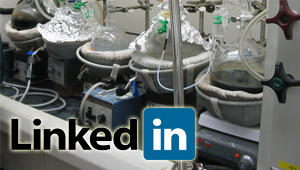The LinkedIn for Scientists: LinkedIn
by
 As it turns out, there is a “LinkedIn for scientists” we should all be using. It’s called… LinkedIn. With over 80 million users, LinkedIn provides the infrastructure to build a large and diverse network of professional contacts that benefits scientists as much as any other profession.
As it turns out, there is a “LinkedIn for scientists” we should all be using. It’s called… LinkedIn. With over 80 million users, LinkedIn provides the infrastructure to build a large and diverse network of professional contacts that benefits scientists as much as any other profession.
While several so-called “LinkedIn for scientists” sites exist, it’s important to note that when building a professional network, diversity is extremely important. Why?
According to the NSF 47% of all PhDs in the biological and physical sciences obtained employment in the academic sector in 2006. So the reality is that a majority of us will be searching for employment in different sectors. When stepping out of our academic or research environments, our network should come with us to help the transition, not be left behind.
As a graduate student and postdoc, I resisted signing-up for LinkedIn because I just never thought I’d need it. Then my career took an unforeseeable turn, and I realized the importance of having a diverse network that can help with introductions beyond the bench.
.
Getting Started
Account Setup
Go to LinkedIn and start by entering your most recent employment information and move back from there. Previous schools, jobs and now, even publications can all be shared.
Once you’ve set up a profile, customize the URL to own your Google search results for your name. Standard formatting is to edit the link so it’s your firstnamelastname (as a single word with no spaces). If that’s not available, try flipping it around to lastnamefirstname.
Import Contacts
Don’t want to think about each person you may know individually? Try importing your contacts from standard webmail apps like Yahoo, Gmail, Outlook and others.
Install the Events App
This app allows you to see upcoming events and conferences that may be relevant to you. It also highlights whether any of your contacts will be attending.
Once you’ve got the basics installed, there are plenty of opportunities to expand your use of LinkedIn. You can participate in Groups, look up Company Profiles and browse the Apps to dive a little deeper. Looking for a job? Try the Jobs tab – it will pull up available positions based on keywords in your profile and let you know if any of your contacts may be connected to the position in any way.
The funny thing about networking is that you never know who may be able to help you whether it’s making an introduction, passing along a resume or serving as a reference. So when building a professional network, do yourself a favor and go with the gold standard.
.
Have any suggestions for ways to enhance the experience on LinkedIn for scientists?
.
.


Susan
wrote on November 11, 2010 at 3:05 am
Great post, Alan. The PostDocs Forum recently covered new changes to the LinkedIn Profile. Scientists can now list their publications on their profile. For more information see http://www.postdocsforum.com/2010/10/25/new-linke…
Also make sure to join groups that can help you network with others in your field. The PostDoc Forum LinkedIn group http://bit.ly/LIpostdoc has over 650 members were you can connect with other graduate students, postdocs and PIs.
alan@benchfly
wrote on November 11, 2010 at 9:23 am
Thanks Susan! I updated the post to include mention of the publication functionality as well.
ibot
wrote on November 11, 2010 at 9:19 am
I ended up in marketing after graduate school and was amazed at how common LinkedIn is among "everyone else" – its a must have.
BenchLife: Your Life in the Lab | BenchFly Blog
wrote on November 30, 2010 at 11:40 pm
[…] LinkedIn for Scientists – networking is a cornerstone to finding a job so when building your own personal network go with the gold standard […]
Mike
wrote on January 22, 2013 at 8:09 am
But LinkedIn has no import feature … you have to enter the publications one by one. Ugh! Not worth the effort if you have a large number.